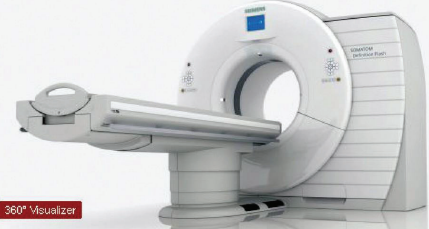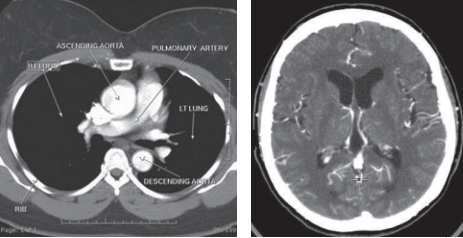Download and print as a PDF (462kB pdf)
On this page
What is a CT scan?
CT stands for Computerised Tomography. A CT scanner is a ‘doughnut-shaped’ machine that uses x-rays to produce more in-depth images of the body. Instead of producing a single picture like an x-ray, the scanner produces many pictures in ‘slices’ through the body.
To produce the pictures, an x-ray machine inside the scanner rotates, emitting a beam of x-rays that passes through the body to a row of detectors on the opposite side.
A computer then transforms the signal received by the detectors from the x-rays into images which are displayed on a TV screen.
CT scans are relatively quick and are good for looking at both bones and the soft tissue structures of the body.
How should I prepare for my CT scan?
Please check your appointment letter for specific information regarding your scan.
You may be required to have a blood test before your CT scan. Your appointment letter will explain if this is required.
If you are taking medication for diabetes, e.g. Metformin/Glucophage, this may need to be stopped before your scan. If you are diabetic please ring the telephone number on your appointment letter for further advice.
Some scans require a litre of water to be drunk over the hour before your scan. For most scans, it is not necessary for you to have a full bladder. You will be told in your appointment letter if this is necessary.
Sometimes we need to give you an injection of ‘dye’ during the scan. This helps us see your internal organs and blood vessels.
This dye contains iodine, which some people are allergic to. If you have a known allergy to iodine, please contact us prior to your appointment. If you have been told that you need this injection, please do not eat anything for 2 hours prior to your scan.
If you have any special circumstances, or requirements regarding the preparation, please let us know.
You may need to spend 10 minutes to 2 hours (though 2 hours is rare) in the department. This depends upon which area of the body you are having examined. We will try to keep to your appointment time, but occasionally we have to scan patients urgently at short notice. This means that your appointment may be delayed. We will let you know if this is the case when you arrive for your appointment.
What happens during the scan?
Depending on the area of your body we need to scan, you may be asked to undress and put on a hospital gown. If you wear loose clothing that contains no metal (like zips, buckles or buttons) you may not have to wear a hospital gown. Please also consider removing jewellery and leaving any valuables at home.
- When you enter the room you will be asked to lie on a narrow, slightly concave bed. Depending on which area of the body we are scanning we may ask you to lie on your stomach or your back. Please inform the radiographer if you think you may have difficulty doing so
- The scanner looks like a large doughnut. You will not be enclosed in a tunnel. The radiographer will be able to see, speak to and hear you throughout the examination

- As the scan commences, the scanner will make a whirring noise and the bed will move in and out of the scanner
- You may be asked to hold your breath for a few seconds as each picture is taken. You should not feel any pain during the scan
- If you are having an injection, you might have a hot flush and get a metallic taste in your mouth. Some patients also experience a sensation like they are wetting themselves; these sensations are normal and pass within moments
If you have any questions at all about your scan, please do not hesitate to ask the radiographer.
What happens after the scan?
If you have had a contrast injection you will need to stay in the department for at least 15 minutes after your scan to make sure you feel well. You will still be able to drive home.
You can eat, drink and go back to your normal activities straight away after your scan. It is advisable to drink plenty of clear fluids over the next 24 hours. This helps your body flush out the dye.
The results will be sent to the doctor who asked for you to have this examination.

What are the risks of having a CT scan?
As CT scans involve the use of x-rays, there is a small risk associated with the radiation dose you will receive.
When your referral form is received by the Imaging Department a team of Radiographers and Radiologists carefully check the request to see if the benefit of having the scan would outweigh the risk of the dose of radiation you will receive.
Although radiographs or ‘x-rays’ have a lower radiation dose associated with them, CT scans provide a more detailed ‘3D’ picture of what is going on inside the body. This can significantly aid your diagnosis or treatment.
If you are required to have an injection for your scan, there is a small risk of having a reaction to the contrast dye. This is a very rare occurrence. When you arrive for your scan, the Radiographers will go through a checklist with you to ensure you are suitable for the contrast dye and minimize this risk. Without the dye, your scan may not be as diagnostic.
If you have concerns about the risk from x-rays or the contrast dye, please contact the clinician who referred you for your scan.
Alternatives to CT
If you are unable to tolerate a CT scan, your referring doctor will be informed and they can decide if an alternative examination may be more appropriate for you.
How to find us
This information is intended for patients receiving care in Brighton & Hove or Haywards Heath.
The information here is for guidance purposes only and is in no way intended to replace professional clinical advice by a qualified practitioner.